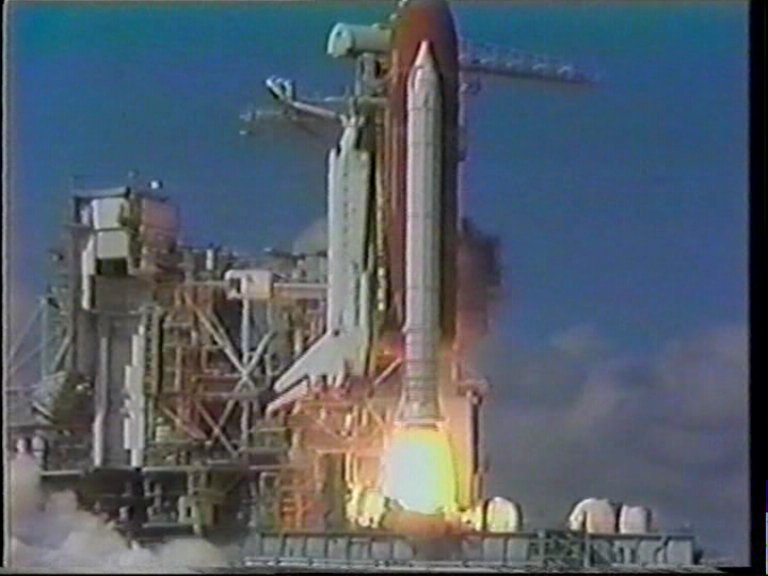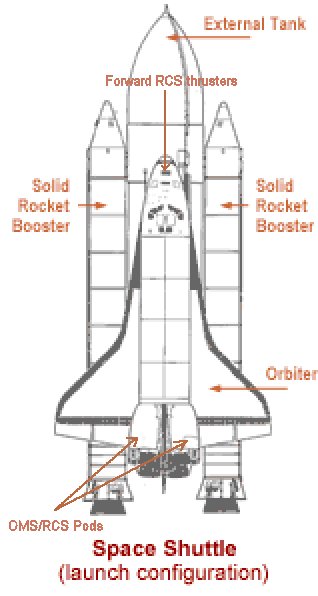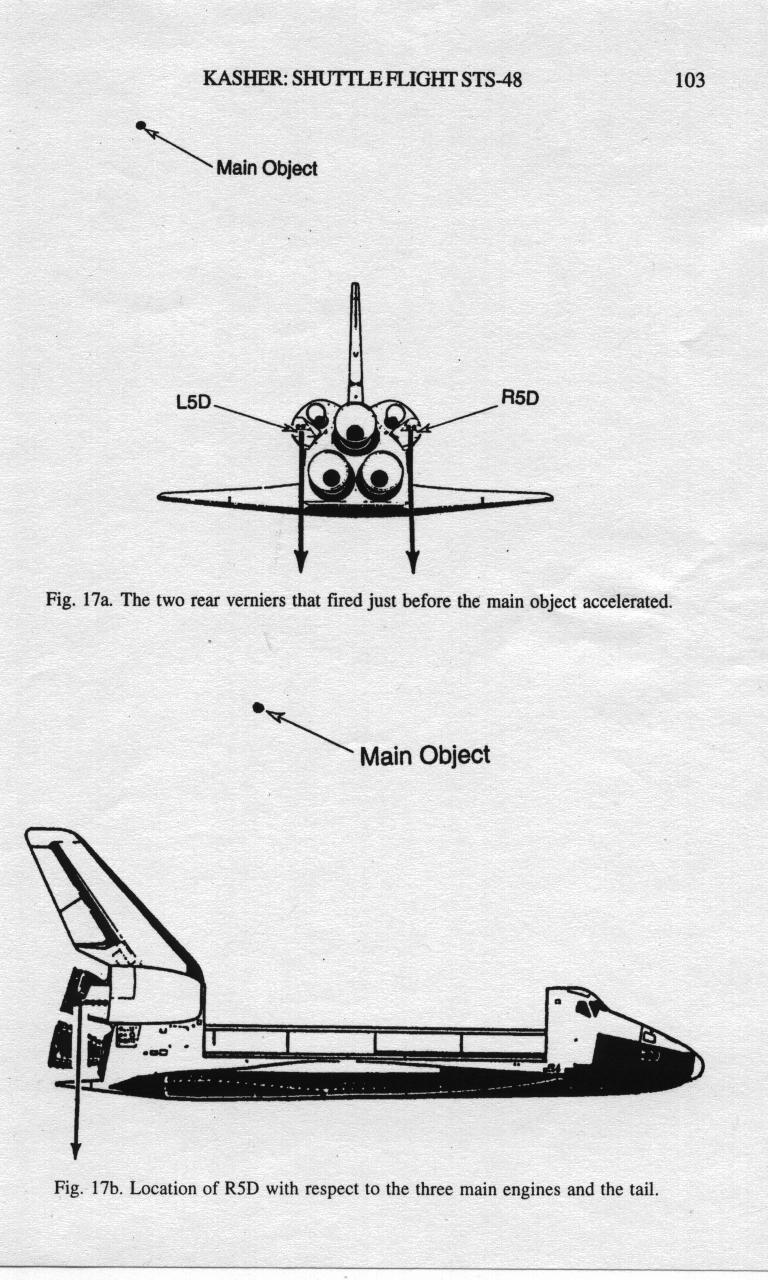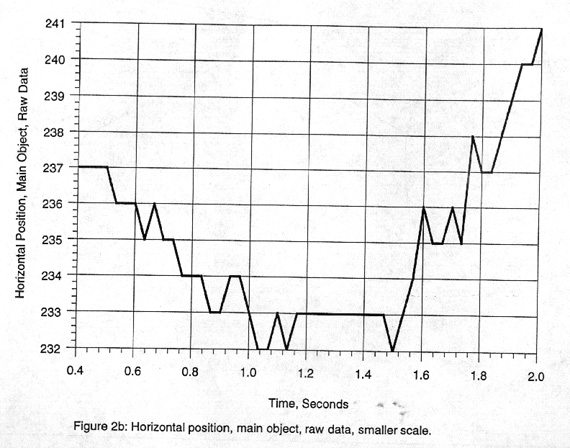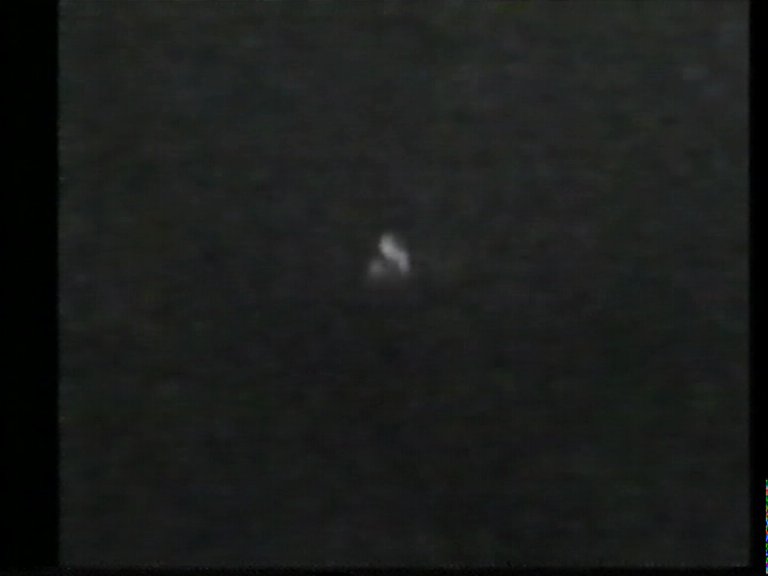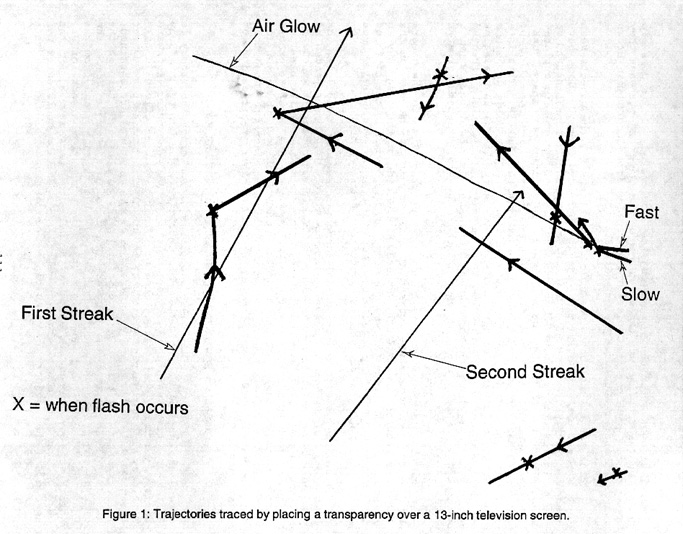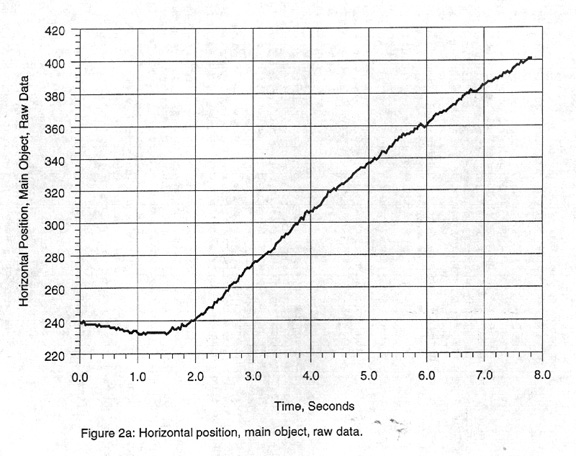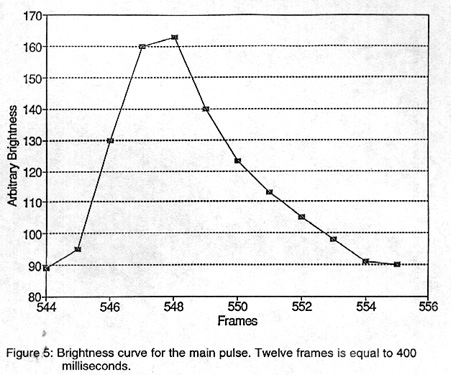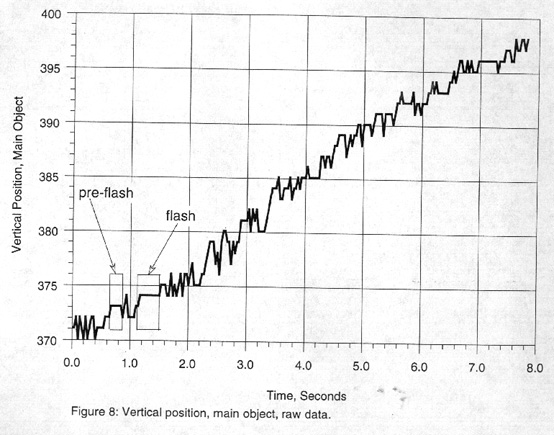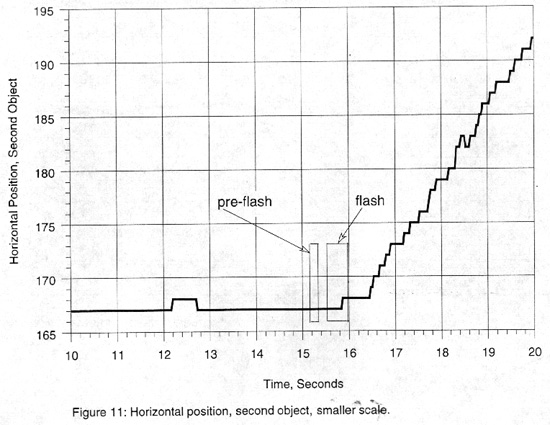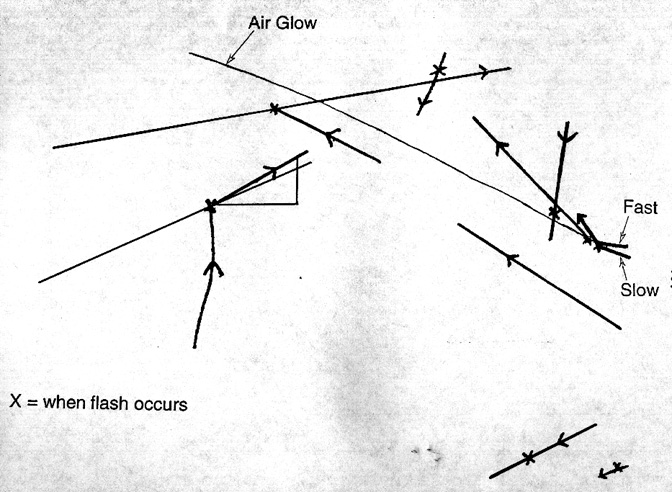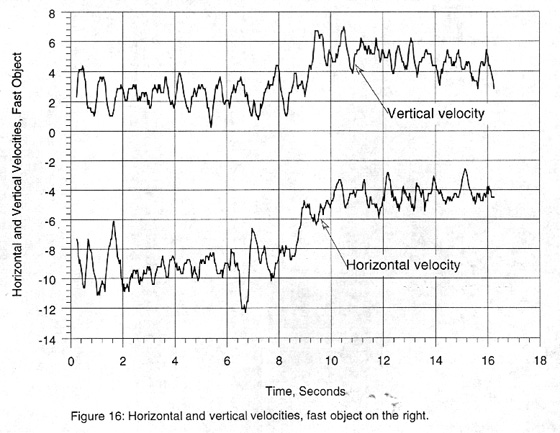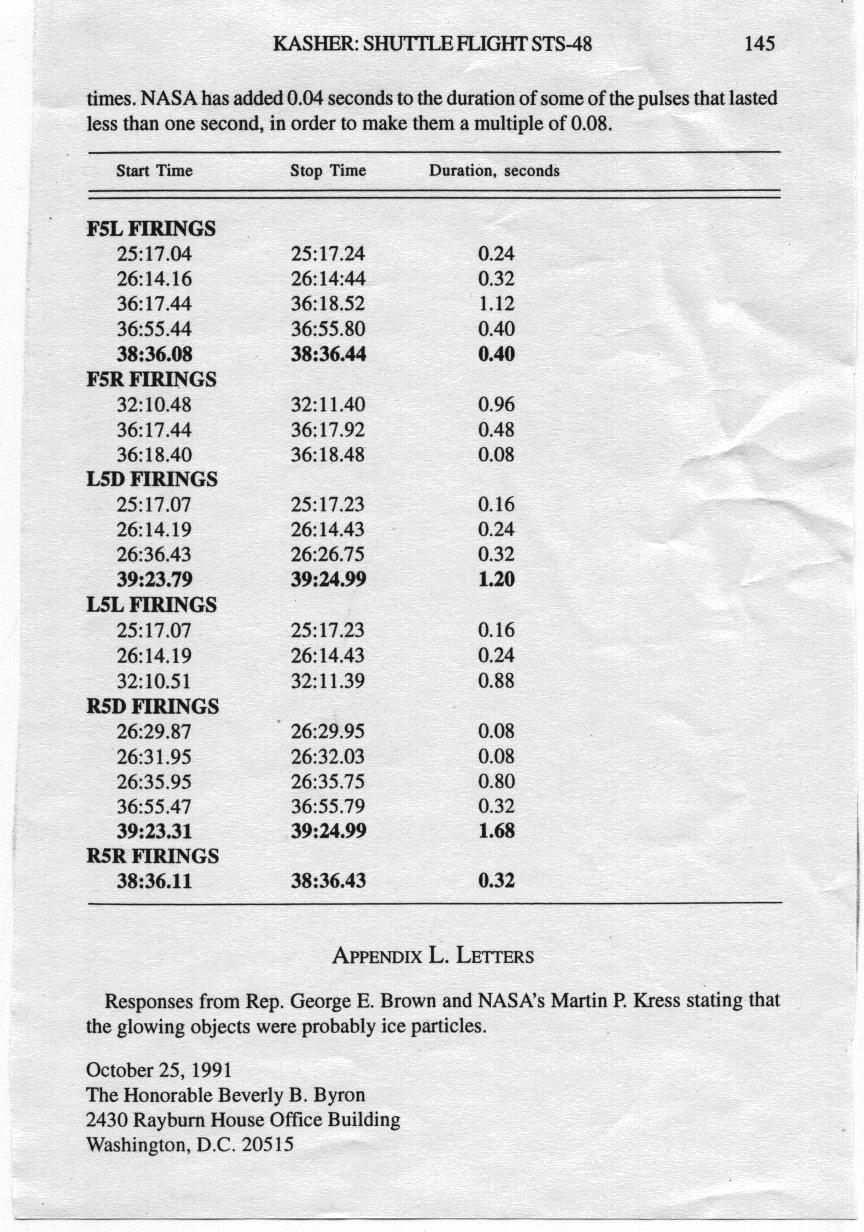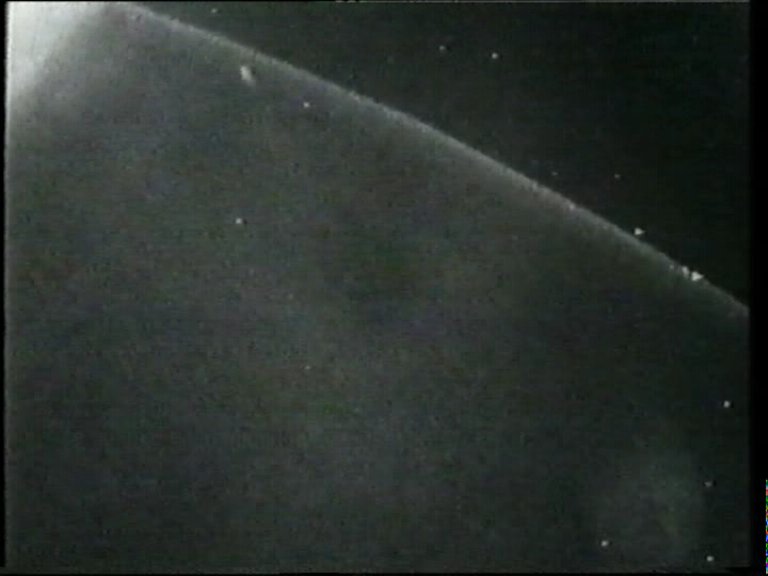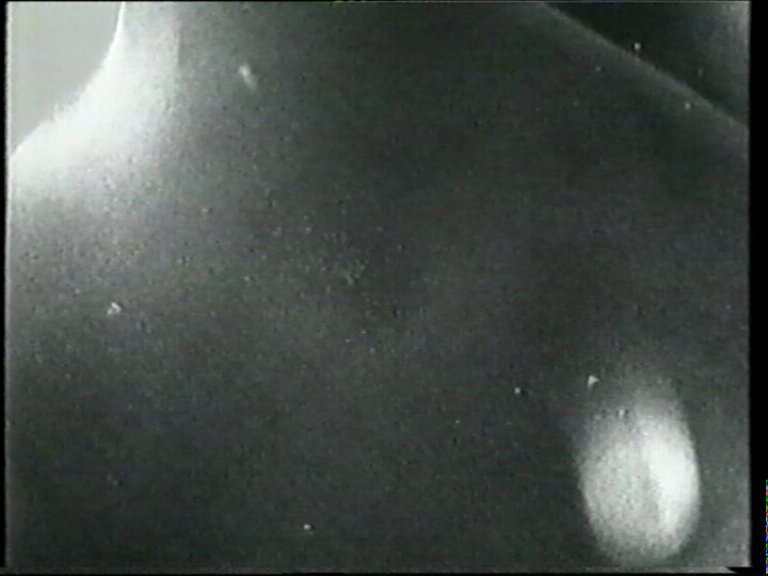|
STS-48: 15
years on
On September 15sup>th,
1991, a camera at the rear of the shuttle’s payload bay captured
something extraordinary. Focused on the distant, curving horizon,
over Australia, a violent thunderstorm raged three hundred miles
below Discovery. Between the Earth and the shuttle, several objects were
moving in seemingly random paths. All of a sudden, another object
appeared from over the horizon and began moving to the left of the
camera’s field of view.
Suddenly there was
a bright flash from the far left and the new object streaked away it
the depths of space. Several, but not all, of the other objects also
altered their courses. A second later, two streaks flashed through
the frame, one of which passed close to where the new object had
been.
What had the
payload bay camera just witnessed? This would be a question that
still causes heads to be scratched fifteen years later.
NASA’s explanation
was that the objects were nothing more than ice particles and their
sudden motion was caused by the source of the flash, Discovery’s manoeuvring
thrusters.
This explanation
did not sit well with many researchers, though, and one, Dr Jack
Kasher, a physicist from the University of Nebraska and in the
employ of NASA also, set about to test the ice particle theory. His
method was to try and prove that the objects were indeed nothing
more astounding than the chunks of ice that follow all space
flights, but what his analysis proved to him was much more
fascinating and not a little disturbing.
Armed with graphs and charts from the guys in
Milwaukee, Kasher set about trying to prove the ice particle theory.
The OMS engines are used for orbital insertion,
orbital transfer and de-orbit functions, amongst others. Basically,
they move the shuttle in space and are the largest, most powerful
engines after the main ones.
The main RCS engines are used to change the attitude
of the shuttle both in orbit and in the atmosphere. They control the
yaw, pitch and roll functions, as well as small velocity changes
along the orbiter’s axis that may be required. The vernier engines
are much less powerful and are normally used for stabilising the
shuttle in orbit or for station-keeping.
The upshot is that if any of the main thrusters were
the cause of the flash on the screen, then the angle of the horizon
should have changed as the orbiter moved in space. It didn’t, the
distant horizon remained fixed. Dr Kasher calculated that if any of
the relevant thrusters had fired, the picture should have rotated
about 6 degrees, a motion that should clearly have been visible.
Let us assume, then, that the flash was caused by
the vernier RCS firing. Remember, the camera is located at the rear
of the payload bay on the right hand (starboard) side. It is looking
across the left (port) side of the shuttle and up at an angle of
roughly 50-70 degrees from the main body of the shuttle. The camera
is focused to infinity, so we can see the horizon clearly.
Dr Kasher worked out that if the objects were ice
particles, with the camera focused to infinity, the objects would
have been about 65 feet or so from
Discovery to be in focus.
The verniers can fire from 1 to 125 seconds in steady-state mode or
in pulses of 0.08 seconds. NASA designs its engines to produce a
purely laminar flow, meaning that the exhaust remains, as much as
possible, in a steady, even stream. The exhaust gases do expand,
obviously, but could they reach a point almost a hundred feet from
the shuttle at such a steep angle and still affect debris
It should also be noted that the flash in the
footage lasted for almost 0.4 seconds. So neither the steady-state
thrust (1-125 seconds) or the pulse-mode thrust (0.08 seconds) match
that timeframe. James Oberg countered this by suggesting that the
camera only picked up part
of the thrusting manoeuvre, so we only saw the back end of it, so to
speak.
Using the trajectories of the two main objects,
Kasher was able to discount that it was the RCS thrusters that
caused them to move. He found that, drawing lines back from their
trajectories after the flash, they did not converge on where the
thrusters should have been. In fact, they diverged, never meeting at
all!
Next, Kasher worked out (still assuming these were
ice particles, remember) the actual velocities of the objects in the
film, compared with what their speeds should have been if they were
influenced by the thruster’s exhaust.
Also, the object, if an ice particle, should be
about 65 feet from the shuttle. It reacts half a second after the
main flash. This means that the exhaust velocity should be about 130
feet per second. As we have seen, the velocity of the gases from the
vernier rockets are in the order of 8,400 feet per second, so this
is another example of how the object cannot be an ice particle close
to Discovery.
Now, as we know the exhaust velocity of the vernier
thrusters, we can work out how far the ‘ice particle’ would have to
be from the shuttle if it took half a second to react to the flash.
It turns out that it would have to be 22.2 miles from
Discovery! Also, drawing a
line back through the trajectory of the object places the thrusters
14.8 miles behind the
shuttle. It could be argued that the shuttle is zipping through
space and covers 14.8 miles quickly. At an altitude of 354 miles,
the shuttle is travelling at 4.7 miles per second, so it would take
over three seconds to travel 14.8 miles, not the half-second
required to make the numbers fit. Also, it is unlikely that an ice
particle small enough to be affected by the vernier rocket would
even be visible to the camera from 22 miles away.
So, from Dr Kasher’s analysis, he cannot conceivably
conclude that what we are seeing in the footage are ice particles
close to the camera. His calculations seem to suggest that what we
have are large objects, manoeuvring above the Earth’s atmosphere
under their own power.
Kasher also calculated the acceleration of the main
object. As we don’t know exactly how far away the object is, he was
forced to work out figures for different distances:
Obviously these are forces that would crush any
human pilot, were any present.
If the flash is not from the RCS rocket,
then what causes it? Another strange aspect to the STS-48 footage
are two streaks that zip away into space, one of them passing
through the area the main object had been before the flash. What
were they?
It has been suggested that the streaks were actually
missiles fired from the Earth! If so, then they are extremely
fast-moving missiles. A projectile from a rail gun or coil gun or a
beam from a projected energy weapon has also been proposed. Was the
flash from some kind of targeting system?
If the streaks were not just more bits of ice
passing through the frame, then it poses a difficult question. Why
are we shooting at stuff in orbit? The objects easily out-manoeuvred
our attempts, but it is still a scary thought.
There were other objects caught by the camera that
were also affected by the flash. On the right side of the screen,
several objects, with what appeared to be flashing lights, slightly
altered their trajectories after the flash. Other objects, though,
seemed unaffected.
The STS-48 footage has become the stuff of legend in
the UFO community and, despite their best efforts, NASA seems unable
to explain it, sticking steadfastly to the ice particle theory. Jack
Kasher’s calculations seem to prove that they are not so. Other
researchers, such as Mark Carlotto, have also independently come to
the conclusion that these are not chunks of ice close to
Discovery.
Is this definite proof that we are not only ‘not
alone’, but that we are also in conflict with somebody from beyond
our planet?
I contacted Dr Kasher and he graciously answered
some questions:
Dr Kasher, thank you from everybody at
UFO DATA Magazine for
agreeing to speak with us. Anybody with an interest in UFOs will
know of your research into the famous STS-48 footage, but not
everybody will know that you were working for the National
Aeronautics and Space Administration at the time. Are you still
doing research for NASA and if so, what are you working on these
days?
I began my research for NASA in the summer of 1992,
studying supergranules on the surface of the Sun, and continued
working for them off and on until I retired in 2001 from the
University of Nebraska at Omaha after 33 years there. I have not
done anything for them since then.
Are you also still active within the Mutual UFO Network (MUFON)?
I am currently a member of MUFON, and serve as a
consultant in physics, Nebraska State Director, and Central Regional
Director over 20 states in the middle of the USA. In my capacity as
consultant in physics I have most recently helped analyze several
pages of physics equations written by Stan Romanek both after a
hypnotic session and during the night while he was asleep. Most of
the equations are very advanced, and deal with quantum gravity. They
are way beyond anything Mr. Romanek is capable of by himself. As
Nebraska State Director I help organize and run our bi-monthly
meetings, assign cases for investigation, and give UFO talks locally
when asked. As Central Regional Director I communicate with the
State Directors in my region, and offer assistance in any way that
might be helpful.
In the last few years, ufology has been said to be in something of a
decline. Do you agree with this or are you of the opinion that UFO
sightings are actually on the increase?
My general sense is that UFO sightings are at least
steady, if not increasing. I know that here in Nebraska we are
getting more reports now than in the recent past. And the sightings
down in Mexico, and the crop circles in England, continue on as
well. I haven’t made a quantitative study of the issue, though; so I
can only give you my impressions, which are not based on counting
the number of sightings worldwide.
Going back to the STS-48 footage, your analysis has become a
benchmark for the study of this particular case. Do you stand by
your findings, that what appears in the film are controlled
spacecraft, or do the arguments from NASA, that they are ice
particles agitated by
Discovery’s thrusters, now seem more likely?
I have not changed my opinion about the STS-48
footage. I still think that the objects in the video were not ice
particles, but rather spacecraft out in space away from the Shuttle,
exhibiting flight characteristics well beyond anything we are
capable of here on the Earth.
In your analysis of the STS-48 objects, you implemented some
equations that gave you the trajectories, velocities etc. of the
objects based on their motion in the film. Some sceptics, such as
James Oberg, have suggested that your figures are wrong. Do you
still stand by them and have any of the debunkers come up with
alternative figures?
To the best of my knowledge no one, including James
Oberg, has come up with a detailed, rigorous, scientific analysis
proving that my calculations and figures are wrong. Debunkers MUST
do this, if they wish to defend the ice particle theory. Since they
have not presented this analysis, and since more than ten years have
passed since I published my calculations, I assume that no one can
show that I am wrong. I wholeheartedly stand by my calculations and
figures. To prove the objects were ice particles, it is not enough
to simply watch the video and make a qualitative judgment. A
rigorous quantitative analysis is needed.
There is another aspect of the video that has been
somewhat overlooked. After the main flash, and immediately after the
bright objects move in apparent reaction to the flash, two streaks
move in straight lines up from the lower left of the picture into
the regions where the objects had been. One of these streaks moves
through the previous location of the main object, and the other goes
through the right side of the picture, where two other objects had
been. These two streaks are clearly of a different texture and
appearance than the glowing objects of interest. They have a fuzzier
appearance, move in straight lines, and their trajectories can be
traced back to a common point that is below the lower part of the
screen. No one from NASA has commented on or tried to explain the
different appearance of these two streaks, which are obviously very
strange ice particles, if that is what they think they are. In
addition, the timing of the two streaks is very coincidental, if
they are ice particles.
There has been a multitude of other NASA footage showing anomalous
objects, possibly the most widely known being the ‘tether’ footage
from STS-75. What are your thoughts on some of this other evidence?
I have always had a problem believing the tether
footage from STS-75 shows some anomalous event. The tether itself is
about 13 miles long and less than a centimeter thick. In the footage
the thickness of the tether is way, way out of proportion to its
length. This suggests to me some distortion in the picture caused by
a camera effect. Until this can be clearly explained, I will find it
difficult to interpret the tether footage in terms of something
extraterrestrial. The best analysis I have seen is by James Oberg,
at
http://www.rense.com/general/stsd.htm.
Another Shuttle flight I find very interesting is
STS-80. There were several unusual objects moving in very strange
ways. The cameraman obviously noticed them, because in one instance
he zoomed in on three objects as they moved fairly evenly around the
right side of the Earth. I can’t say what the objects were. It would
be nice if someone at NASA had tried to explain them for us.
Have any NASA astronauts commented to you about STS-48, STS-75 or
any other UFO footage? What is the feeling amongst them about UFOs
in general?
No astronauts have ever contacted me or commented to
me about my analysis of the STS-48 footage or their belief in UFOs.
However, Gordon Cooper has very clearly and publicly commented on
his experiences, especially the case when a saucer landed on the
runway at Edwards Air Force base in California when he was stationed
there in the 1960s. Anyone wishing more details about Cooper’s
experiences can find them in his book, Leap of Faith.
Edwin ‘Buzz’ Aldrin recently stated in the television documentary,
Apollo 11: The Untold Story,
that on their way to the Moon in 1969, Armstrong, Collins and
himself saw an unidentified object travelling alongside their craft.
I mean, if it wasn’t a section of their own launch vehicle, then
what could it have been? Something from the earlier Apollo missions,
prior to the landing, perhaps? He also claimed that NASA ordered the
men not to discuss the incident afterwards. What impact do you think
this disclosure will have and do you believe it is a part of the
overall disclosure program to drip-feed the public into the reality
of the UFO/alien visitation subject?
I didn’t see the documentary, so I can’t comment
from first hand knowledge. But if they saw something on the way to
the Moon, before they got there, then it is very, very unlikely that
it was something from the earlier Apollo missions. It would have to
be trapped in orbit, and there wouldn’t be an orbit at that
location. Also, you would think that the astronauts would recognize
something from their own launch vehicle. So it is difficult to say
what it was that they saw. It is also very interesting that NASA
told them not to discuss the incident.
My opinion about an overall disclosure program by
NASA is purely speculation; but I strongly doubt that NASA is doing
this.
What do you make of the old stories that the Apollo astronauts saw
‘something’ while actually on the lunar surface? There’s a famous
tale, for instance, of Armstrong and Aldrin seeing alien spacecraft
‘lined up’ on the edge of a crater. Remembering that the UFO
sighting whilst en route to the Moon was essentially folklore for
many years, do you think anything will happen with regard to this
more dramatic story
Like most of us in the UFO field, I am aware of this
interesting rumor. I find it quite fascinating, and would love for
it to be true. But I don’t think we’ll ever have the evidence to
prove it. It would take a major press conference by all the
astronauts involved, and I don’t think that will happen.
Since STS-48, has anything from NASA relating to UFOs piqued your
interest that the general public might not be aware of?
I have no secret files or confidential cases to
disclose. Those I find most interesting, like the STS-75 and STS-80
footages mentioned above, are known to the general public.
Recently, the British Ministry of Defence (MoD) released a document
to the public that suggested that most UFOs, those that could not be
explained as terrestrial technology, were weird atmospheric
phenomena such as plasmas. Have you had the chance to examine the
report and, if so, what do you think of its conclusions?
I have not read the report first hand, and have only
seen summaries of it. But it appears to me to be far-fetched to try
to explain most UFOs as atmospheric phenomena. I wonder how many of
the more than 3,000 trace cases studied by Ted Phillips were
included in their report. I would guess none, since these cases
would simply blow their conclusion out of the water.
2007 is likely to be a big year for ufology, being the sixtieth
anniversary of the Roswell Incident. No doubt the mainstream media
will latch onto it and we will be inundated with UFO-based
programming for a while, probably some good, but more likely, mostly
bad. What do you think of the way the mainstream media handles the
UFO subject? For instance, the current series of The History
Channel, UFO Files, is an
excellent example, in my opinion, of good, mainstream UFO
programming. At the other end of the spectrum, here in the UK, we
suffered The World’s Strangest UFO Stories on Discovery, which handled the
subject with a great deal of ridicule.
I would give the mainstream media mixed reviews for
their coverage of UFO issues. I was disappointed with the Peter
Jennings report last year on ABC; and the major networks at least
part of the time seem to lean too much toward scepticism. But, as
you point out, The History Channel has produced a good number of
fine, objective programs recently. When I watch one I always look
forward to a solid, fair treatment of whatever issue they are
presenting. I hope this trend continues throughout 2007.
What are your plans for the future and how do you see ufology
progressing in the years to come? Do you think we will ever get
definitive answers or is the UFO enigma going to remain just that,
an enigma?
I plan to continue working for MUFON in the three
capacities mentioned above, especially applying my knowledge of
physics when I can. As far as the future of ufology is concerned, we
can always hope that the big breakthrough is just around the corner.
But I recall a comment made by Dr. Leo Sprinkle at a presentation of
his I attended some years ago. Someone asked if he thought we would
have these definitive answers very soon, and he replied (I’m
paraphrasing him) “Yes, I certainly do, very soon. I thought that in
the 1960s, and in the 1970s, and in the 1980s, and in the 1990s.” In
other words, we always appear to be on the brink of the big
discovery, but never quite seem to get there. But it’s fun to keep
trying.
Thank you for taking time out of your busy schedule to speak with
us, Dr Kasher. Everybody at
UFO DATA Magazine wishes you all the best for the future.
© Steve Johnson - 2006
|
